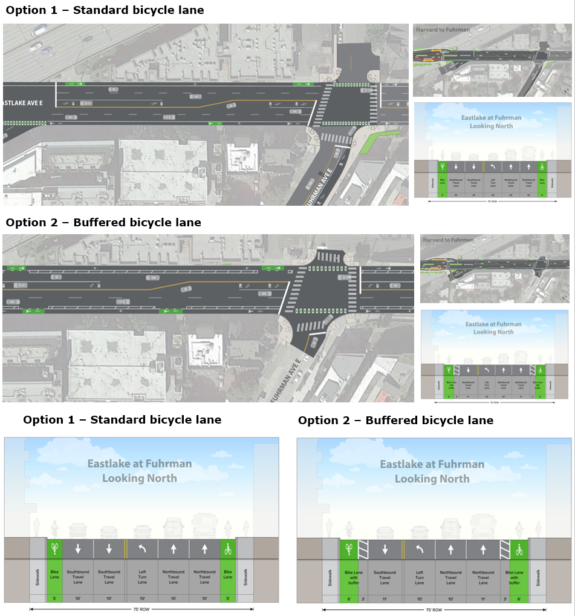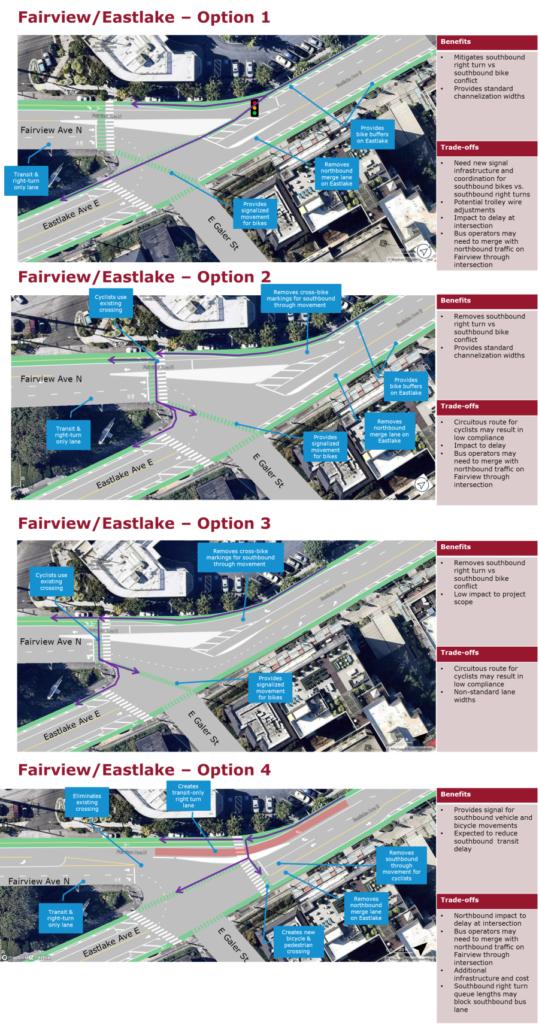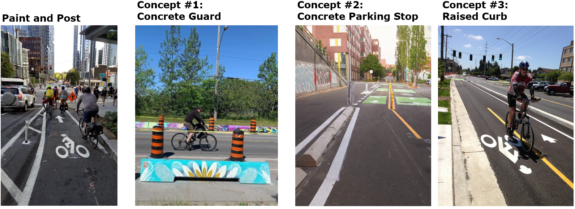
Whatever you are doing, stop and fill out this quick survey to support safer bike lanes on Eastlake as part of the RapidRide J project. You can also attend one of two virtual community design sessions Wednesday from 12–1:30 p.m. or 6–7:30 p.m. (register here).
There are three major questions pertaining to bike safety in the survey. But let’s start with the highlight: The block south of the U Bridge. The current plan would maintain the existing skinny, paint-only bike lanes, and we have written repeatedly arguing that the project needs to add more protection. So it is very exciting to see Option 2, which widens the bike lane and adds some buffer space. This would be a huge improvement over the previous plan, though it would be best if there were some protection to prevent people from parking in the bike lane.
 The survey also presents four options for the intersection at 11th Ave NE and NE 43rd Street. At this point, the bike lane had been planned to switch from the right side of the one-way northbound street to the left side, though that decision was made when the RapidRide line was going to run all the way Roosevelt Station or even Northgate Station as was the original plan. The idea was to reduce conflicts with the RapidRide bus stops and the bike lane.
The survey also presents four options for the intersection at 11th Ave NE and NE 43rd Street. At this point, the bike lane had been planned to switch from the right side of the one-way northbound street to the left side, though that decision was made when the RapidRide line was going to run all the way Roosevelt Station or even Northgate Station as was the original plan. The idea was to reduce conflicts with the RapidRide bus stops and the bike lane.
However, the bus line now ends at NE 43rd street, which calls into question whether the bike lane should switch sides at all. Unfortunately, that is not one of the options presented. If nothing else, this intersection change requires the city to also have a full 11th/12th Ave NE bike lane ready to build at the same time that will need to reach NE 75th Street, where the bike route shifts to two-way on Roosevelt. If the left side bike lane doesn’t reach 75th, then there will need to be another transition somewhere along the way, which would be absurd.
But if the bike lane will be constructed on the left side all the way to NE 75th, then the lane will need to change sides. In that case, either option 4 or a mix of options 3 and 4 seem the best. If someone biking uphill arrives when general traffic has a green light, there will be a huge incentive for them to not stop, at least not until they get across the intersection. And unlike Option 1, which provides essentially no guidance on what to do, Option 4 provides a clear space to wait for the light to change. Option 3 will likely happen whether there is space for it or not as people take advantage of the red light to cross to the correct side of the street. Option 3 also helps create space for people who take advantage of a break in traffic to merge left early.
 Another tricky intersection is the flux capacitor intersection where Fairview Ave N meets Eastlake Ave E. Options 2 and 3 are concerning mostly because the route is very confusing and inconvenient for people continuing straight on southbound Eastlake, which is a significant number of people. Option 1 allows the most straight-forward route option, though it relies on a new traffic signal, so signal timing will be important in order for it to work well. Option 4 is the most creative, though the crosswalks are probably the worst. An option that included the crosswalk in Options 1–3 in addition to Option 4 might be the best. I’m also a bit surprised that there is no option that includes a northbound bus-only lane on Fairview, which would allow them to use a bus jump signal and avoid traffic backups. That’s the primary benefit of Option 3, which is the worst of them all.
Another tricky intersection is the flux capacitor intersection where Fairview Ave N meets Eastlake Ave E. Options 2 and 3 are concerning mostly because the route is very confusing and inconvenient for people continuing straight on southbound Eastlake, which is a significant number of people. Option 1 allows the most straight-forward route option, though it relies on a new traffic signal, so signal timing will be important in order for it to work well. Option 4 is the most creative, though the crosswalks are probably the worst. An option that included the crosswalk in Options 1–3 in addition to Option 4 might be the best. I’m also a bit surprised that there is no option that includes a northbound bus-only lane on Fairview, which would allow them to use a bus jump signal and avoid traffic backups. That’s the primary benefit of Option 3, which is the worst of them all.
 And finally, the survey asks for thoughts on the type of bike lane barrier that should be used. Honestly, I don’t understand why they are even asking this. This is a major, high-budget roadway rebuild, of course they should use permanent materials like concrete. Paint and post bike lanes are temporary materials, making them inappropriate for a high-budget rebuild project. Regular people are not going to care about whether the curbs are cast-in-place or precast or need to be installed with a forklift, they just want it to be durable and safe. The city should be building whatever level of protection is needed to maintain safety and prevent people from parking in the bike lane. It’s more of an engineering question than a public opinion question. The public should be asked things like, Would you prefer flower planters or space for murals? The public are not experts on what kinds of curbs are best at stopping cars. Of the options, I suggest concrete curb since it is the most purposeful and permanent option, though I have no idea if the entire length needs a curb like that.
And finally, the survey asks for thoughts on the type of bike lane barrier that should be used. Honestly, I don’t understand why they are even asking this. This is a major, high-budget roadway rebuild, of course they should use permanent materials like concrete. Paint and post bike lanes are temporary materials, making them inappropriate for a high-budget rebuild project. Regular people are not going to care about whether the curbs are cast-in-place or precast or need to be installed with a forklift, they just want it to be durable and safe. The city should be building whatever level of protection is needed to maintain safety and prevent people from parking in the bike lane. It’s more of an engineering question than a public opinion question. The public should be asked things like, Would you prefer flower planters or space for murals? The public are not experts on what kinds of curbs are best at stopping cars. Of the options, I suggest concrete curb since it is the most purposeful and permanent option, though I have no idea if the entire length needs a curb like that.
UPDATE: Cascade Bicycle Club sent out the following action alert:
The Seattle Dept. of Transportation is hosting two virtual community design sessions this Wednesday, Sept 14th at 12-1:30pm or 6-7:30pm (meeting registration links here). There will be a presentation and discussion of several elements of the bike lane that will be built along Eastlake. There are two items in particular that SDOT needs to hear from us:
1. The final blocks of Eastlake just south of the University Bridge still need full protection. Originally designed as paint-only, there is now the option to add space for a buffer. This is progress, but SDOT needs to hear that this area needs full barrier protection to create a safe space for biking.
2. Concrete barriers for bike lane protection along the rest of the route. There are four options in total: Plastic posts are a start, but SDOT needs to hear that concrete barriers help people of all ages and abilities stay safe while biking.












Comments
16 responses to “SDOT survey asks if they should improve the bike lane south of U Bridge (yes, obviously) – UPDATED”
“This is a major, high-budget roadway rebuild, of course they should use permanent materials like concrete. ”
Yes, but given the nature of a lot of this, the city might want to hedge their bets. I can see lots of places where things *could* be much worse than expected (for buses or bikes). A less “permanent”, cheaper barrier might be a good idea if they end up changing things. I agree though — this shouldn’t be part of a poll.
“I’m also a bit surprised that there is no option that includes a southbound bus-only lane on Fairview, which would allow them to use a bus jump signal and avoid traffic backups. That’s the primary benefit of Option 3, which is the worst of them all.”
Don’t you mean Option 4?
Oops, I meant northbound. Sideways map threw me off. I’ll fix it.
Ah, that makes more sense. I had option 3 at the bottom of list as well.
For the first choice, Option 2 is clearly better, both for bikes and buses. The existing plans allow cars to essentially pass the bus,slowing down the bus when it has to then merge later. You can see this in the slides — https://www.seattle.gov/documents/Departments/SDOT/TransitProgram/RapidRide/Roosevelt/2020_1130_RRJ_ConceptDrawings.pdf. This would eliminate some of the delay for the buses.
When taking the survey, please add a comment urging that a physical barrier be included to separate the bike lane from traffic – including on that one-block stretch South of U Bridge!!! Delivery trucks frequently park in these bike lanes, making them far less safe/effective. Southbound, regular commuters also speed from the light at Furhman trying to beat the light just past Harvard, at the pedestrian crossing under I-5. We need a PHYSICAL barrier here more than any other stretch of Eastlake Avenue!
For Fairview & Eastlake, I chose option 1. The primary deciding factor for me was to keep northern movement through the intersection simple. Option 1 gives me the chance to not wait for the special traffic signal if no vehicles are coming (though not legal), and then I can zip across Fairview and continue north without waiting a full cycle.
While I appreciate the protection the right turn signals give to cyclists, they can also add a lot of travel time since they drastically reduce the amount of time allocated to go straight through the intersection.
A better solution would be to have a flashing red signal for bikes when the adjacent traffic lane has a green light. Then it would be legal for a bike to proceed with caution.
“Option 1 gives me the chance to not wait for the special traffic signal if no vehicles are coming (though not legal), and then I can zip across Fairview and continue north without waiting a full cycle.”
Can’t you do that with option 4 as well? It seems safer to run that light than it does with option 1 (not that I would do either).
I don’t think you can do it as safely with option 4. There are two right turn lanes to cross and you have to pause in between the two, possibly with traffic rushing on both sides of you, to cross the second lane.
My only qualm with physical barriers is if they put them on Eastlake north of Fuhrman, it’s going to make it super annoying to make a left turn on to Fuhrman.
Not the focus of the overall project, but I hope they don’t degrade that already-rather-shitty turning movement.
I’m guessing the intent is that you make a right turn/u turn, rather than merging with car traffic to get into the left turn lane.
Shocked no one has mentioned that concrete barriers will make it really hard for cyclists turning left at Harvard to merge with traffic for that left? The Harvard left-turn has been the site of so many cyclist collisions.
The current plan is for cyclists to turn left at the next lights. I think this is the only safe option as merging with a left-turn car lane will never be safe. You can see the plan here: https://www.seattle.gov/documents/Departments/SDOT/TransitProgram/RapidRide/Roosevelt/TRC0082_Roosevelt_Corridor_Outreach.pdf
This plan also shows option 2 south of U bridge drawn in, option 2 for 11th and 43rd, option 3 for Fairview Ave N and Eastlake Ave E. The stations on Roosevelt explicitly mention they are still being reviewed unlike the other options. Make of that what you want.
In the big picture, the J Line should never have been planned for the Roosevelt couplet or to extend that far north. The Roosevelt Way NE PBL, 2016, should have been placed on the left side. A couplet is a lousy place to place serious transit. Perhaps the couplet is the issue. Could it become two two-way arterials again between NE 75th Street and the University Bridge? bikes could have two PBL on Roosevelt; buses could have in-lane stops on 11th/12th avenues NE; riders transferring between bus and Link at Roosevelt station would have shorter walks. In the U District, the SDOT J Line alignment imposes longer walks on northbound J line riders bound for Link, other bus routes, the Ave, or the UW campus. Why? The Route 70 pathway already exists. SDOT is spending more and degrading the transit network.
I absolutely agree that Roosevelt and 11th/12th should be two-way streets. This was briefly discussed early in the process, but didn’t go anywhere.
Yes. $120 million to cut the number of bus stops for the Route 70 in half, plus make it far less convenient for the ridership. Or is the Rapid Ride J just a 2 mile bike lane project?